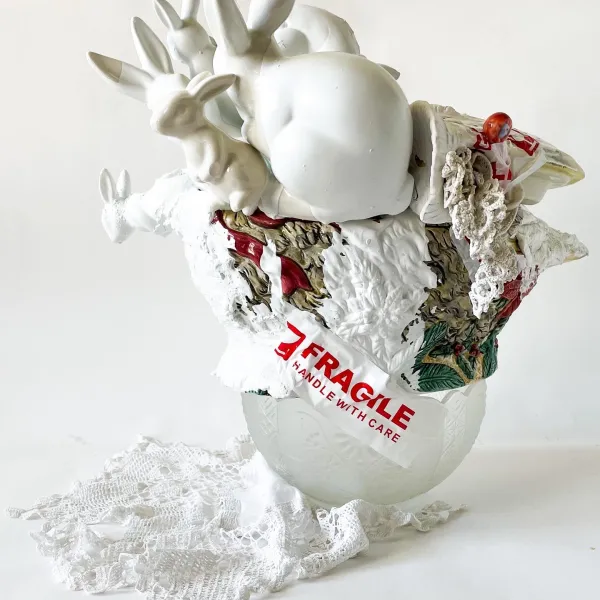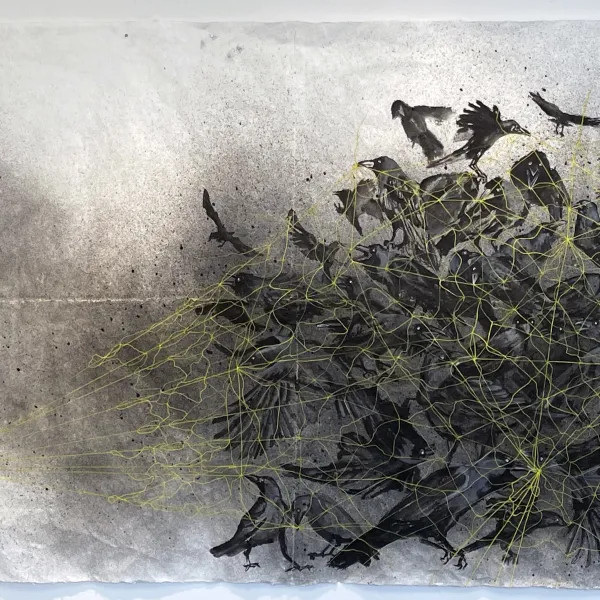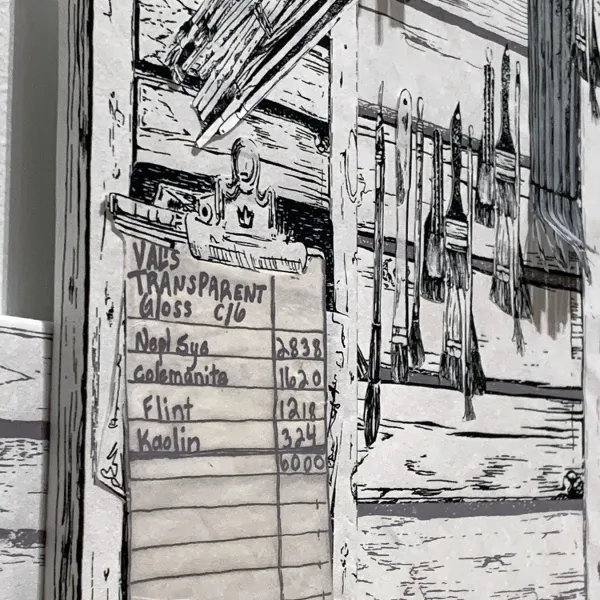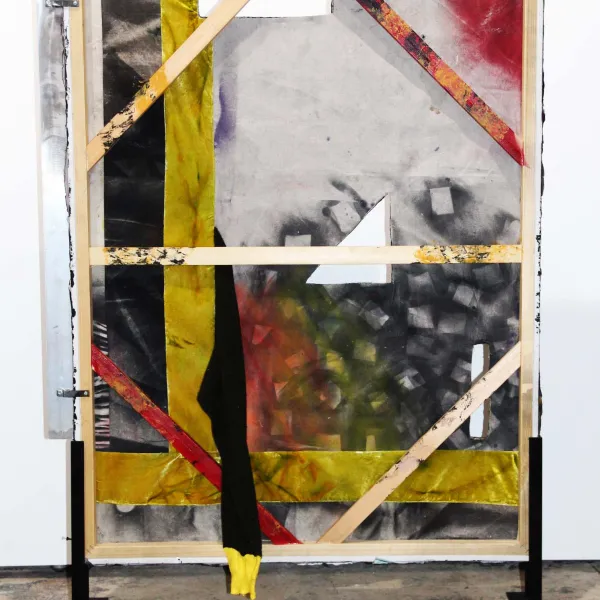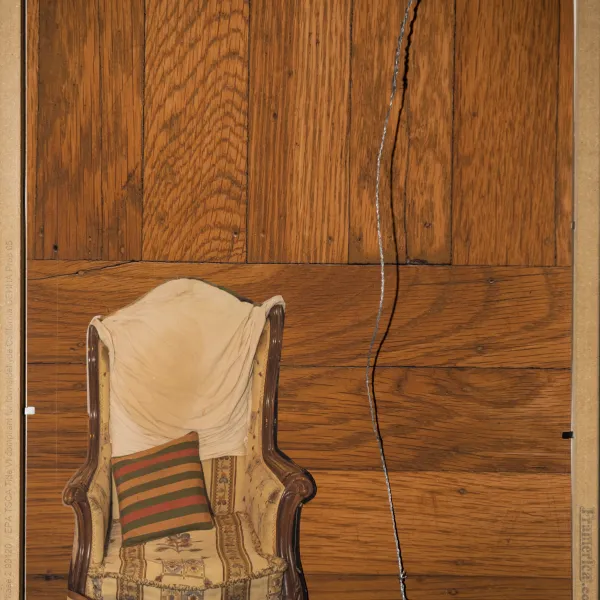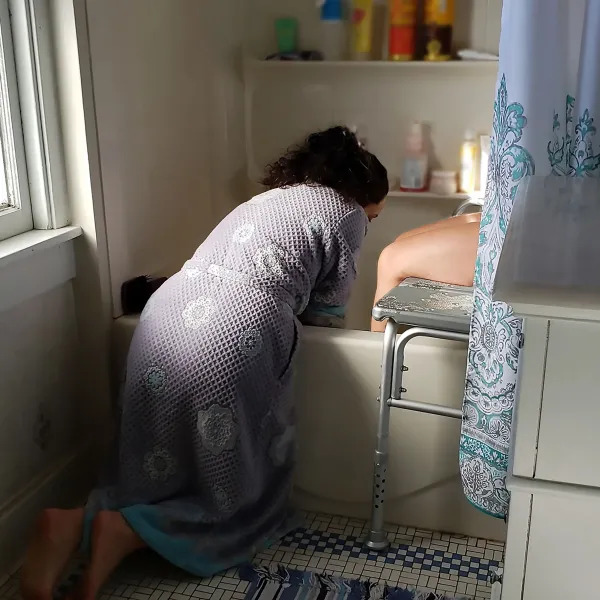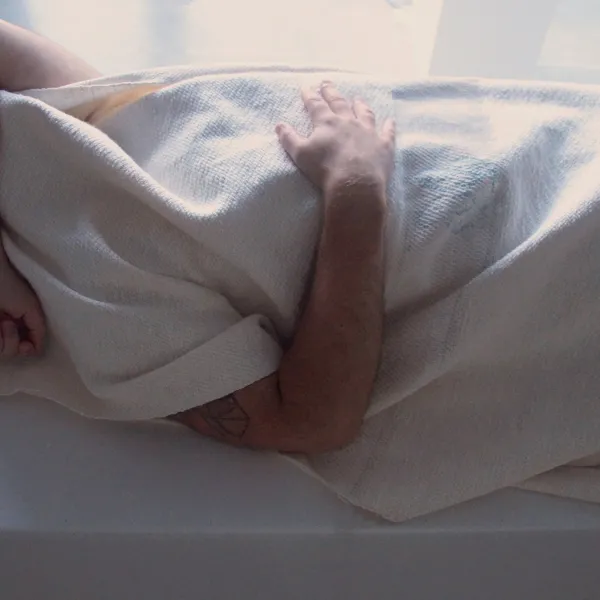November 4, 5–7pm
Aesthetics of Loss is an exhibition of work by nine artists who turn to their art to express their experiences of losing loved ones. The curators explain: “[Artists’] studios became places for processing grief and understanding the vacuum of losing loved ones either suddenly or over a long period of illness. Caregiving, memory, loss, and the ultimate mystery of death are explored through painting, printmaking, fibers, ceramics, photography, installation, and video.”
“Representing grief in artwork is an attempt at understanding death and there is no one way to do it. Some artists utilize objects and clothing left behind by their loved ones and transform them into artworks, and others use ritual and natural materials as memorial or commemorative actions of grief and acceptance. In the work of artists in this exhibition, art is an unconscious survival barrier, a scrim that references something unimaginable in oblique, evocative, and moving ways.”
Loss, Ritual and Meaning – A Panel Discussion: Monday, November 6, 5–6:30pm CST.
Visual Arts Building, rm. 102 and Zoom. Free and open to the public. RSVP here by Tuesday, October 31.
Drawing on their experiences as theologians, artists, and healthcare practitioners, the panelists explore how the experience of loss is shaped by their professional and disciplinary roles.
Virtual Artist Discussion: Wednesday, November 29, 6:30pm CST. A Zoom link will be emailed to participants in advance of the event. RSVP here by Wednesday, November 22.
Educator & Visitor Guide: This guide is designed as a resource for all visitors, especially college educators and their students, who are eager to engage meaningfully with the artwork on view in the gallery. The content in this guide offers a range of learning opportunities and styles, with the goals of building observational skills, encouraging dialogue, cultivating critical thinking and personal reflection, and ultimately, appreciating art as a form of learning, understanding, and creating a pathway for building empathy, relationships and community at St. Kate’s and beyond.
Curators' Statement
Aesthetics of Loss is a collection of work by nine artists who have experienced the recent loss of friends and family members. Their studios became places for processing grief and understanding the vacuum of losing loved ones either suddenly or over a long period of illness. Caregiving, memory, loss, and the ultimate mystery of death are explored through painting, printmaking, fibers, ceramics, photography, installation, and video.
Representing grief in artwork is an attempt at understanding death and there is no one way to do it. Some artists utilize objects and clothing left behind by their loved ones and transform them into artworks, and others use ritual and natural materials as memorial or commemorative actions of grief and acceptance. In the work of artists in this exhibition, art is an unconscious survival barrier, a scrim that references something unimaginable in oblique, evocative, and moving ways.
Jessica Meuninck-Ganger poignantly illustrates how a life is made up of a million little pieces. Delicate assemblages of Korean paper printed with her father’s tools of the trade (as in Val’s Transparent Gloss) express a sense of rising and going away as well as the grief embodied in the renderings of things left behind. Similarly, Magpie, inspired by her mother’s collection of snow globes, are metaphorical cabinets of curiosity encasing fragments of her mother’s memories and her craft.
“Death” in representation seems one-dimensional and abstract, losing all the wholeness of lived moments. In Cassidy Early’s work, however, missing body parts, empty notepads, and dandelions narrate a landscape where symbols of their mother, their trans identity, and the Dungeons and Dragons game all exist in dream-like compositions where death is confronted in full color.
Intimacy is inescapable when one witnesses death, demanding that we acknowledge and confront the most vulnerable parts of ourselves. This aspect is present throughout the exhibition but especially in the work of Anders Zanickowsky, whose commissioned burial blankets lend themselves to acknowledging the fragility and ephemerality of our bodies while inviting us to honor these impermanent bodies with a beauty and grace that is uniquely ours. The weaving materials and their creation are an intimate dialogue with craft, oneself, and the audience.
The first few days after losing a loved one are filled with a shock that is akin to the floor tilting towards you or a hallway appearing extra long. The draped photographs by EBTI emote powerfully this skewing of time and space. Combined with the closed window and the many empty chairs in the photos, the installation is one of distortion and haunting absence. Similarly, in Jaymee Willms Harvey’s work, the loss of stillborn twins is communicated with breakage that is felt in one’s body and the paradox of still being alive after such a loss. Here, logic is elusive while pain is palpable.
Nirmal Raja’s Peace Offering is a call to the wild. Inspired by the Hindu practice of offering rice and black sesame seeds to crows in rituals of mourning, she seeks logic and transcendence in the interconnectedness of nature and the cycle of life. Death is often understood as the end of someone, an inherently abrupt and violent stoppage. While this violence is present in the transformation of materials as in Early’s painted fragmented bodies, Marcus’s cut and frozen garments, Harvey’s broken and mended sculptures, and Raja’s incineration of clothing, it is also an undeniable rearranging. Work by these artists begs us to see death as a transformation from one material state to another rather than a permanent end. They urge us to view death as simply a moment of transition. “Dying is like being born: just a change,” said the Chilean-American writer Isabel Allende.
But not all ends are abrupt and nor are they painless. The relentlessness of caregiving is something we rarely honor and acknowledge. Here, it is represented in the work of Linda Marcus’s videos and painting of airplane tarmacs during her innumerable trips to care for her mother and sister as well as Brianna Hernández’s photographs, videos, and gilded caregiving tools. The tiresome, mind-numbing repetition and the most intimate and painful acts of everyday caregiving are rarely talked about. The work of these artists lets us bear witness to this aspect of end of life.
Addressing caregiving is an important subject in this exhibition. In order to address the silence associated with aging and dying, Meuninck-Ganger and Anne Basting created a unique event for this exhibition. Drawing on the traditions of similar transformations of life, they hosted a “Care Shower” for friends in colleagues in the Twin Cities community. Much like a bridal shower or a baby shower, the artists normalized a shower that supports and celebrates the unique journey of a caregiver, with activities that draw on communal resources and wisdom.
Aesthetics of Loss is a survey of artworks that are a mediation of grief, where no one work is like the other, but collectively the works offer the viewer a space for healing and acceptance of the inevitable.
Virtual Artist Discussion, Wednesday, November 29, 6:30-8pm
Artists Anne Basting, Cassidy Early, EBTI,
Jaymee Harvey Willms, Brianna L. Hernández, Linda B. Marcus,
Jessica Meuninck-Ganger, Nirmal Raja, Anders Zanichkowski,
and Curators Linda B. Marcus, Jessica Meuninck-Ganger and
Nirmal Raja discuss their work in Aesthetics of Loss,
moderated by Gallery Director Nicole Watson.
Image Gallery
Click an image to view in larger size
